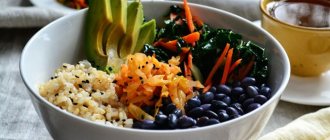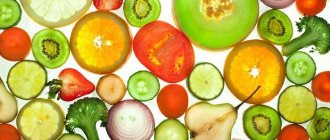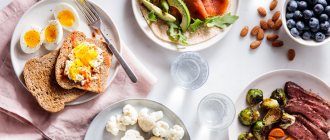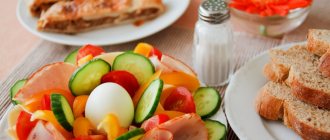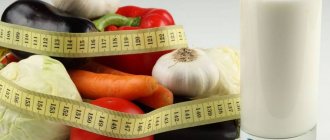Why do you need to give up carbohydrates?
There is an opinion that during drying it is necessary to completely eliminate carbohydrates and give preference exclusively to protein nutrition. In fact, for a highly effective result, you need to reasonably limit carbohydrates, or rather, minimize them (low-carbohydrate diet), but in no case give them up completely. This is due to the fact that carbohydrates are a source of energy; their intake increases endurance and performance. For those who think this theory is wrong, you can conduct a small experiment. Try eating exclusively protein for a few days. As a result, you will notice how quickly fatigue sets in during training, energy and strength disappear, drowsiness appears and decreased performance.
It is enough to completely give up simple carbohydrates, which do not provide any benefits for health or weight loss. Once you exclude them, the body will have nowhere to take energy from; it will have to use existing reserves in the form of fat deposits.
Pros and cons of a no-carb diet
A no-carbohydrate diet is not a balanced one. Moreover, it is considered one of the extreme. Nutritionists do not recommend using “drying” more than twice a year. Not everyone is able to withstand a strict diet combined with mandatory training.
Only self-discipline, motivation and attitude will bring success in working on an ideal body.
In the first days of carbohydrate restriction, weakness, apathy and decreased ability to work will appear. Then the body will get used to the new conditions, and unpleasant sensations will be less frequent. In the final stages, the smell of acetone may appear on your breath. This is a companion to all protein diets. Periodic dizziness due to acute carbohydrate deficiency can be relieved by taking a small amount of natural fruit juices.
Protein-rich foods provoke an exacerbation of chronic problems, the liver and kidneys suffer. Lack of fiber causes disruption of the gastrointestinal tract: heaviness and constipation appear. The brain senses a glucose deficiency. This manifests itself in a clear decrease in thought processes, loss of attention and concentration. A person may experience constant irritation and even become depressed.
The undoubted advantages of a low-carbohydrate diet for weight loss include:
- lack of feeling of hunger;
- fast pace of weight loss;
- long lasting effectiveness.
How the body works when you give up carbohydrates
With a sharp change in the usual diet, certain chemical reactions occur in the human body. It is worth noting that with carbohydrate-free drying, the calorie content of foods is only a secondary factor. What matters is what you eat. A sharp decrease in carbohydrates leads to the fact that the body has to convert other reserves into energy, in this case they are fat deposits and muscles. Of course, it is easier for the body to get rid of muscle than fat. Muscles are a foreign body for our body and do not bring any benefit. For this reason, in addition to drying, it is necessary to regularly train so that in the process of a kind of weight loss you do not lose muscle mass. In this case, the body begins to process fat reserves.
It is important! Physical activity is important to achieve the desired effect. The training plan is individual for everyone. To compile it, it is recommended to contact specialists.
Who is this diet contraindicated for?
A carbohydrate-free method of losing weight in combination with sports is prohibited for people with the following health problems:
- dystrophy, lack of muscle mass;
- diabetes;
- disorders of the nervous system;
- infectious diseases;
- disorders of the gastrointestinal tract;
- liver and kidney diseases;
- low immunity.
The path to an ideal body lies through a special diet and intense physical activity, so before drying you need to consult a doctor.
attuale.ru
What foods should you avoid on this diet?
Let us remind you that even when drying, we exclude only fast carbohydrates and minimize the consumption of complex ones. On average, your daily diet should contain about 30 grams of complex carbohydrates. To understand what 30 grams of carbohydrates are, consider the table:
| Product | Amount of carbohydrates per 100 grams |
| Cottage cheese | 2 grams |
| Apple | 5 grams |
| Bread | 50 grams |
| Cucumber | 10 grams |
| Oat groats | 56 grams |
| Milk chocolate | 59 grams |
| Egg | 3 grams |
We can conclude that the maximum amount of carbohydrates is contained in sweet and flour products, for this reason, first of all, you need to give up them. Significantly lower amounts of carbohydrates are observed in chicken eggs and cottage cheese. It is worth noting that fish and dietary meat do not contain carbohydrates at all. Vegetables and fruits contain minimal amounts of carbohydrates.
When following a low-carbohydrate diet, it is recommended to avoid certain types of foods that contribute to the growth of subcutaneous fat. In addition to the ban on sweets and flour, the following should be excluded:
- Any drinks that contain alcohol.
- Products containing excessive starch content. These include not only potatoes, but also corn and legumes.
- Dairy products that contain questionable substances. These include flavoring additives and artificial colors.
- You should not buy ready-made meals. When preparing them, various sauces and flavor enhancers are often added, which are strictly prohibited on a carbohydrate-free diet.
Before you buy any food, be sure to read the ingredients on the package. Try to avoid unnatural products. Various trans fats and chemical additives are harmful not only to the drying process, but also to health.
Primary requirements
The main rule of such a nutritional system is to consume a limited amount of carbohydrates. It is allowed to eat carbohydrates daily, the calorie content of which should not exceed 250 calories. It is prohibited to exceed this figure.
To comply with the main rule, flour and bakery products, starchy fruits and vegetables are excluded from the daily diet. According to the authors of this diet, they are the main reason for gaining excess weight. Just 250 calories are enough, coming in the form of complex carbohydrates. Their sources can be porridge, whole grain cereals, and vegetables.
Meals should be divided into 5-6 meals during the day. The last meal is no later than three hours before bedtime. The duration of the diet should not exceed two weeks.
What products are in priority
To achieve the intended result, experts recommend keeping a small notebook and counting carbohydrates. As mentioned earlier, on this diet you are allowed to consume no more than 50 grams of carbohydrates. The daily diet should consist of meat, it is advisable to give preference to a lower-calorie option - poultry or rabbit meat. Pork, veal or lamb meat is allowed in moderation.
Also, do not deny yourself the consumption of fish, which does not contain carbohydrates at all. Among the less high-calorie varieties, it is worth noting pollock or flounder. Red fish will be no less useful. Low carbohydrate content is found in eggs, cottage cheese and other dairy/fermented milk products. When choosing them, you should choose products with the lowest fat content. To ensure that the diet is as varied as possible, women can come up with many recipes based on permitted foods.
It is important! Since a person needs 50 grams of carbohydrates per day, it is best to consume them from vegetables and fruits, preferably citrus fruits.
Drinking regime
When drying, 80% of the diet is vegetables and fruits. As you know, when taken in large quantities, various problems with the gastrointestinal tract can occur, since they contain a lot of fiber. Metabolism may be inhibited or the digestibility of food may deteriorate. To prevent possible troubles, it is recommended to follow a drinking regime. Depending on the individual characteristics of the body, the volume of liquid may vary, but in general it is worth sticking to 2.5 to 3 liters of clean water per day.
Experts also encourage the enrichment of table water with mineral salts using the drug Regidron. This powder product is diluted in water, the dosage is used three times less than indicated in the official instructions for the drug.
What varieties are there?
The diet has two options.
The optimal one is chosen taking into account health capabilities and the expected result:
- Gentle. The menu reduces the carbohydrate part to 125 g/day. The diet is easy to tolerate, but weight loss is slow.
- Strict. The mass of carbohydrates is strictly limited to 20-40 g per day. Gives quick and impressive results. Used under the supervision of a nutritionist according to an individual diet, selected taking into account the characteristics of the body.
The principles of carbohydrate-free nutrition are also used in other protein diets - Dukan, Kremlin, Montignac, keto diet.
Low-carbohydrate diet: menu for the week
Note that at the beginning of drying it is strictly forbidden to immediately reduce the amount of carbohydrates to a minimum. The drying menu should be rational and balanced. The diet is individual for everyone; it is better to entrust its preparation to a specialist in this profile. Let's consider a sample menu of a low-carbohydrate diet for a week:
- Day 1. On the first day, we reduce the usual amount of complex carbohydrates by about half. So breakfast is the most important meal of the day in order to store energy for the whole day; most carbohydrates are taken in the first meal. You can cook oatmeal with pieces of apples and eat one boiled egg with herbal tea. The next meal is essentially a snack, so just drink a glass of kefir. For lunch we prepare boiled squid, cucumber and herb salad, season with a little olive oil and lemon juice. For an afternoon snack, you can eat a fresh pear and a glass of kefir. 2-3 hours before bed we eat a portion of cottage cheese with dried fruits and a boiled egg.
- Day 2. In the morning, prepare an egg omelet with skim milk, a slice of cheese and chicory. For a snack, cottage cheese seasoned with natural yogurt. At lunchtime, steamed vegetables and boiled chicken. A couple of hours after lunch - a glass of fermented milk drink. For dinner, a salad of finely chopped cabbage with fresh tomatoes, a piece of steamed red fish.
- Day 3. We eat two boiled eggs and boiled chicken breast for breakfast. As a drink, green tea, preferably without sugar. Green apple for snack. For lunch we prepare seafood soup and Brussels sprouts salad. One grapefruit for afternoon snack. A few hours before going to bed - a portion of buckwheat porridge with a piece of butter.
- Day 4. For breakfast, two pieces of cheese, a hard-boiled egg, and a portion of cottage cheese. For second breakfast, a jar of natural yogurt without artificial flavors or fillers. At lunchtime, a stew of stewed zucchini and eggplant, a piece of any baked red fish. For a snack, a handful of peanuts with almonds. For dinner, stewed cabbage and boiled rabbit meat.
- Day 5. The first meal consists of a medium-sized fresh cucumber, two boiled eggs and cheese. For second breakfast you can eat one banana. Lunch consists of boiled squid and stewed vegetables. As a snack - a handful of dried fruits. For dinner, one green apple and cottage cheese with low-fat sour cream.
- Day 6.7. On weekends the menu is the same. For breakfast, oatmeal with pieces of fresh pear and a glass of kefir. For a snack, cabbage salad with vegetable oil and lemon juice. For lunch we eat mashed potatoes with baked chicken breast. For an afternoon snack, a glass of fermented baked milk or kefir. The last meal consists of chicken gulal and pearl barley porridge. As a drink - a glass of green tea.
It is important! Never skip meals to avoid disrupting your metabolism.
Rules for quitting the diet
A severe carbohydrate deficit gives quick and high-quality weight loss results.
But an incorrect return to your usual diet can just as quickly return your weight to its original point.
Getting out of a diet is no less important than the process of losing weight itself. Carbohydrates are reintroduced into the diet gradually, increasing the amount consumed by 10 g every week.
Suitable for the first days:
- “safe” cereals;
- quality pasta;
- wholemeal bran bread;
- low carb fruits.
It is important to continue to eat small meals, at least 5 times a day. Fat consumption should be limited.
It is useful to adhere to the “green plate” principle:
- 1/2 serving – vegetables and herbs;
- 1/4 serving – any healthy grains or beans;
- 1/4 serving – foods containing protein (fish, chicken breast).
At the final stage, the carbohydrate content increases to 90-120 g per day. This is the optimal volume when balancing BZHU for the body’s vital functions and maintaining normal weight.
It is better not to stop physical activity. It is not necessary to train intensively in the gym; brisk walking and exercises in the morning are enough.
How long can you stay on a no-carb diet?
The duration of a unique diet for burning subcutaneous fat is strictly individual. First of all, you should start from your own feelings and well-being. After a week, some feel a decline and lack of energy, for this reason they switch to daily nutritious nutrition and do not achieve the desired result. Others see excellent results after a month of a low-carb diet. At the same time they feel good. The average duration of a carbohydrate-free diet is from 2 to 6 weeks.
It is important! The main mistake when following a low-carbohydrate diet is an incorrectly composed diet, because it is individual for each organism. Before going dry, consult a nutritionist.


